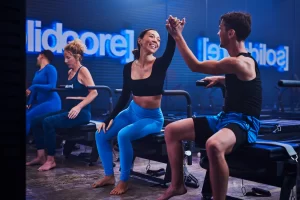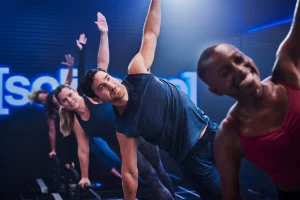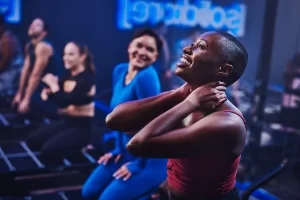
fact or fiction – [solidcore] myth busters
Let’s cut to the chase: there’s a lot of rumors out there about [solidcore]. Trying something brand new for the first time can be intimidating, but we’re here to set the record straight. Check out some of the things people are saying, and see if you can tell if they are fact or fiction.

#1: [solidcore] is Pilates
not quite!
But we get why it’s confusing – our [sweatlana] machine is a Pilates-inspired reformer, but that’s where the similarities end! A typical Pilates class will focus on deep breathing, whereas [solidcore] has a deeper focus on resistance and strength training.
Our workout predominantly focuses on heightenting resistance and stimulating each muscle with slow and controlled movements, which help target slow-twitch muscle fibers. By focusing on time under tension, muscular endurance and strength are increased. While we’re grateful for Pilates for our roots, our workout takes a more amplified approach.
#2: moving slow isn’t effective
try again!
While moving fast has more of a cardio component involved, the slow and controlled movements you perform in class stimulate and trigger those slow-twitch muscle fibers. Being fatigue-resistant, they can sustain tension for a long time.
By moving slowly, muscles undergo more metabolic work per second. Maintaining tension is necessary for achieving muscle failure during the controlled stage, which results in muscle growth. This takes a traditional exercise, like a lunge, to the next level.

#3: shaking is a good thing
you can say that again!
Embrace the shakes, baby. The shaking of muscles is caused by the nervous system attempting to recruit more muscle fibers to complete the repetition at hand. As muscle fibers fatigue, more motor neurons fire. The impulses that fire throughout the nervous system and to the target muscle fibers cause the muscle to twitch and shake.
#4: [solidcore] is too challenging for me
a workout catered to you
For the 50 minutes of a [solidcore] class, you will experience high-intensity, low-impact exercises that are made to challenge you. Whether you’re a gym guru or newbie to working out, your coach will cater the experience to best fit you and your needs. Spring loads allow for clients to add or decrease resistance based on their experience level, and coaches are actively present for the entirety of class to give verbal & physical support to help you feel supported throughout class.
Most exercises you hear in class come with the ability to modify or amplify – these will help you pave your own path to achieve muscle failure. While many people view modifications as “less intense” in a workout, performing an exercise with proper form and full range of motion is significantly more effective than performing a move improperly.
Look for a starter50: intro to [solidcore] or foundation50: build your basics* class in your studio’s schedule – these introductory classes are great for beginners, as coaches move slower through the exercises and provide more context. Regardless of skill level, you will for sure leave feeling [empowered].
*Please note that foundation50 classes are only available in select studios.
#5: I workout all the time, so [solidcore] won’t make me sore
challenge accepted
While your time hitting the weights at the gym is great, you’ve never experienced a workout like this. As mentioned earlier, your slow-twitch muscle fibers will be worked to failure.
At the gym, growing muscular strength is a common goal and can be reflected by a muscle’s ability to lift a load. At [solidcore], we train for muscular endurance — meaning we train your muscles to be fatigue-resistant and continuously work against an external force. Both training methods are effective and will improve your overall performance and health.
- Muscular strength: muscle’s ability to lift a load (ie. lifting one very heavy box). Programming for this incorporates high-weight loads and faster movement for a short period.
- Muscular endurance: muscle’s ability to resist fatigue over a sustained period (ie. moving boxes for an entire day). Programming for this incorporates lighter weight and slow movement for an extended period.

#6: I’m going to be sore the next day
we sure hope so
Because of the muscle stimulation that you encounter in class, your body will spend the next 24 hours repairing the micro-tears. Some of the exercises you perform in class can cause onset muscle soreness, usually peaking around 24-72 hours after exercise. While everyone will experience muscle soreness differently based on their exercise routine, delayed onset muscle soreness is common after a class. This is why it’s super important to stretch after a class, hydrate properly, and refuel your body with high-protein food and carbohydrates.

Did you know your stuff? If you have any further questions about whether or not this workout is right for you, reach out to your local studio and speak with a coach!
Ready to find your [strength] within and experience a total transformation in mind and body? Explore our memberships and learn more about our [solidcore] new client specials today.
